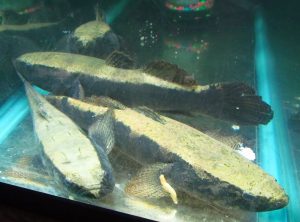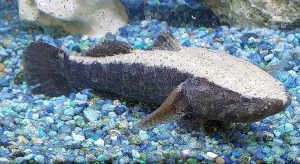The Spotted Sleeper Goby (Eleotris picta) is a large species that is also known to tropical fish keeping enthusiasts as the Spiny Cheek Sleeper Goby, Water Cow, or Water Cow Goby.
Several species of Sleeper Gobies are found in fresh and brackish water rivers, estuaries, and coastal regions throughout the Indo-west Pacific, from the eastern coast of Africa to the Hawaiian Islands, and in many parts of their range, they appear to reside only in fresh waters.
Although Spotted Sleeper Gobies are found in a variety of habitats including brackish estuarine and coastal areas, they are most often found in small coastal freshwater streams.
The Spotted Sleeper Goby inhabits rivers with low to high currents which generally occur in freshwater and occasionally in slightly brackish waters at the river mouths.
Smaller specimens are normally more abundant near the coast where they feed on small shrimp and fish. Only larger individuals are found upstream.
Sleeper Gobies occur in American Samoa, Australia, Bangladesh, Cambodia, China, Christmas Island, Comoros,Fiji, Hong Kong, India, Indonesia, Japan, Madagascar, Malaysia, Mauritius, Micronesia, Mozambique, Myanmar, New Caledonia, Palau, Papua New Guinea, the Philippines Réunion, Seychelles, Singapore, Solomon Islands, South Africa, Sri Lanka, Swaziland, Taiwan, Province of China, Tanzania,the Hawaiian Islands, Vanuatu, and Viet Nam.
The Spinycheek Sleeper Goby has a broad head, a robust body, a short snout, a large mouth with a protruding lower jaw, with an upper jaw that extends to the middle or end of the eye. They have several rows of teeth on their jaws, with an outer row of canines in the rear and an inner row where the jaws meet at the front of the mouth. The front nostril overlaps the upper lip, the rear nostril is an open pit, and the gill openings extend to below the opercle. All species have a strong forward pointing spine embedded in the skin at the lower corner of the preopercle which gives them their name.
Sleeper Gobies have two dorsal fins with the base of the second dorsal less than the distance from the end of that base to the tail fin. Except for the tip of the snout, the top of the head, cheeks, opercle, and entire body is scaled with tiny scales. They have no visible lateral line.
Spotted Sleeper Gobies and many other Eleotris species can change their colors depending on their mood, or to camouflage themselves.
The body of the Water Cow can be a tan to dark chocolate brown, usually with a few scattered brown spots on the upper sides and the top of the body being lighter than the sides. Two stripes radiate across the cheek from the eye to the rear, with no dark spots on the upper part of the fish.
Eleotris picta can also be colored a light gray on top, with a darker gray color extending along the sides of the fish to the undersides, which are lighter.
Sleeper Gobies are primarily bottom dwelling predators. They are a sedentary species that when disturbed by larger fish, seldom get overly agitated however, they should never be housed with inverts or fish smaller then themselves, or they will be quickly devoured.
Don’t let their docile nature and inactivity trick you into putting them into a community tank setting. They spend most of their time scanning the aquarium for potential prey and if it can fit into the Goby’s mouth, be assured the Goby will eat it.
This is one species that is best kept in a single species tank, or with peaceful fish larger than themselves.
Juvenile Sleeper Gobies can be housed in at least a 55 gallon aquarium until they grow out, and then transferred into at least a 100 gallon planted tank, with a medium to fine gravel or sandy substrate, some rocks formed into caves for them to hide among, and some driftwood or bogwood. They will stay on or near the bottom of the tank and like to rest on the rocks and driftwood when they are not hiding in the rock work or in the substrate.
Although they are adaptable to a variety of water conditions, they do require a good filtration system and a powerhead to provide some current in the tank.
Sleeper Gobies have not been bred in an aquarium environment. They have pelagic eggs and larvae.
In their natural habitat, “Water Cows” feed on a variety of insects, crustaceans, worms, and fish. In an aquarium environment, juveniles can be fed live or frozen mysis shrimp, brine shrimp, bloodworms, etc. Larger fish can be fed fresh or frozen shrimp, earthworms, mussels, silversides, bloodworms, or appropriately sized chunks of fish. Although some tropical fish keeping enthusiasts feeding their Sleeper Gobies live feeder fish, it should be done only occasionally.
Sleeper Gobies should only be fed once a day. They will eventually recognize their owners and often become quite friendly. Over time they will eat out of the keepers hand.
Sleeper Gobies aka “Water Cows” are occasionally available from specialty fish shops, online, and from importers however, they are not a common aquarium fish.
Minimum Tank Size: 100 gallons
Care Level: Difficult
Temperament: Peaceful
Hardiness: Hardy
Water Conditions: 73°F – 82° F, 10 dH – 30 dH, pH 7.4 – 8.2
Max. Size: 20″
Color Form: Brown, Tan, Gray
Diet: Carnivore
Compatibility: Single species tank
Origin: Indo West Pacific, Africa, Hawaii
Family: Eleotridae
Lifespan: 8 years plus
Aquarist Experience Level: Experienced



